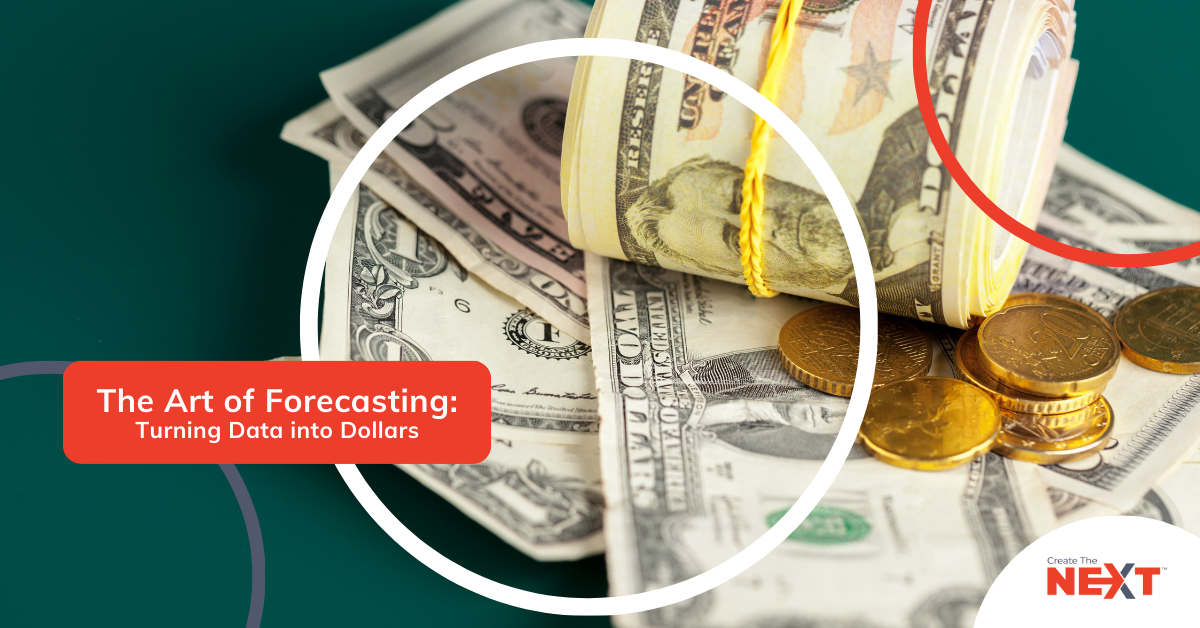The Art of Forecasting: Turning Data into Dollars
Feb 3, 2025
As the business landscape becomes more fast-paced and competitive, financial professionals must use financial forecasting models to predict future performance and make accurate data-driven growth and resource allocation decisions. Effectively utilizing artificial intelligence (AI) and analytical tools can transform revenue forecasting from a guess to a precise, data-based forecast. This article delves into advanced techniques for financial forecasting, and details how fractional CFOs can play a critical role.
What is Financial Forecasting?
One of the key functions of any business is financial forecasting, which predicts future revenues, expenses, and cash flows based on historical data and market trends. These data points support business leaders during financial planning, budgeting, and other decision-making. Forecasts serve as a compass to guide strategic planning and business operations. Realistic financial predictions align financial strategies with business objectives. AI has begun to revolutionize how professionals forecast as traditional methods cannot always capture the complexity of modern business dynamics.
Three Advanced Techniques for Revenue Forecasting
Data-driven forecasts empower informed decisions rather than relying on instinct. Whether expanding into new markets or investing in new technologies, accurate predictions reduce uncertainty. Companies that excel in forecasting will successfully adapt and anticipate changes in consumer behavior.
1. Data-Driven Insights
Data-driven insights in revenue forecasting harness the power of real-time analytics and advanced predictive modeling techniques to generate accurate and actionable forecasts. Enterprises that embrace a data-driven approach consistently outperform their peers, demonstrating up to 4% higher productivity and 6% greater profitability. This methodology leverages innovative tools such as machine learning and AI to process complex datasets, uncovering patterns and trends that traditional forecasting methods might overlook.
By integrating dynamic data inputs businesses can refine their revenue predictions. This adaptability allows for agile decision-making, enabling companies to proactively modify their strategies and optimize financial performance. Moreover, as businesses continuously recalibrate their predictive models with new data, they are positioned to exceed their financial objectives, ensuring long-term success and resilience in a rapidly changing market environment.
2. AI-Powered Predictive Analytics and Machine Learning
AI has revolutionized financial forecasting by enabling predictive analytics, changing how companies rate and analyze the financial health of a business as 80% of FP&A teams project more accurately and efficiently with AI tools. Predictive analytics can forecast future financial trends based on historical data, helping businesses make informed decisions about revenue projections and market share.
Machine learning (ML) is the technology that powers automated financial forecasting. ML can analyze large data sets to capture trends and impactful data. They identify insights that traditional analytics cannot, and the algorithms have a deeper understanding of the industry and the performance of a business.
Generative AI (Gen AI) is the most recent technology that has advanced the financial services industry. It enhances fraud detection, enables personalized services, and overcomes data limitations. Gen AI is crucial in automating comprehensive financial reports such as income statements and balance sheets. It can also generate synthetic data to aid in simulations and scenario planning.
3. Real-Time Monitoring
Real-time monitoring in forecasting represents a shift, enabling businesses to track and analyze data as it unfolds, thus facilitating immediate adjustments to predictions based on the latest information. In contrast to conventional approaches that depend on periodic data updates, this methodology integrates real-time data streams from diverse sources—such as transactional sales data and consumer behavior patterns. By continuously monitoring these key indicators as they evolve, organizations can detect shifts in demand or unforeseen disruptions, allowing them to make informed decisions.
This capacity for real-time responsiveness enhances the relevance of revenue forecasts, as businesses are not constrained by delayed updates or assumptions. The ability to proactively adjust to evolving conditions not only improves accuracy but also enables continuous model refinement, ensuring that predictions more closely align with the ever-changing market landscape. By leveraging this approach, companies can maintain a competitive edge, mitigate risks, and optimize their strategies in a landscape characterized by volatility and uncertainty.
AI Advances the Future of Forecasting
AI tools facilitate simulations and scenario planning which help financial professionals create strategies that consider future economic and market events. Predictive analytics provide deep insights into various aspects of the market and customer habits, aiding in accurate forecasting. AI tools offer real-time insights enabling financial teams to view data as it occurs and update the forecast accordingly.

The Role of Fractional CFOs in Financial Forecasting
For many small-to-mid-sized businesses, hiring a full-time CFO may not be feasible. This is where fractional CFOs come in, offering expert financial guidance part-time with a full-time commitment. A fractional CFO develops detailed financial models and cash flow projections that guide accurate decision-making. They track key performance indicators (KPIs) to inform strategic decisions and align financial goals with long-term objectives. Fractional CFOs are key in managing cash flow and allocating resources efficiently to stay on track for growth.
Studies show that 82% of businesses fail due to poor cash flow management so having an executive to make accurate financial decisions is crucial. These professionals bring a wealth of experience and specialize in leveraging advanced forecasting techniques to:
- Plan for growth by identifying opportunities
- Optimize cash flow effectively
- Ensure long-term sustainability
ProCFO Partners provide multiple types of businesses with access to fractional CFOs, who tailor strategies to their unique financial needs. By combining financial expertise with data-driven tools, these professionals help businesses turn data into dollars.
Conclusion: Embrace the Future of Forecasting
Financial forecasting is no longer confined to man-made spreadsheets and data. Embracing advanced analytics and AI helps businesses achieve new levels of accuracy and efficiency. Whether navigating growth or planning for the future, the right tools and expertise make all the difference. We would love to introduce you to the modern way to achieve the most accurate and up-to-date forecasts.
Whatever your financial goals are, our expertise and readiness to utilize AI tools can transform your financial strategy. Competing in today’s business landscape can be challenging but with the right financial tools and strategies, you will be equipped to win. Contact ProCFO Partners today.


